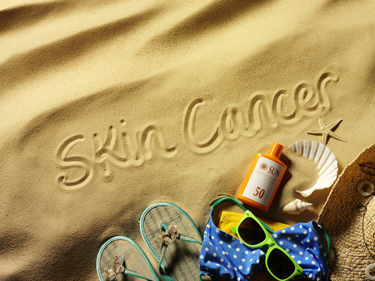Melanoma Is The Deadliest Cancer
You have heard the message by now: Melanoma is deadly. You also probably know that it is the fastest growing cancer in the United States and that one American every hour dies from melanoma. Millimeter for millimeter, it is the deadliest cancer. Rather than bore you with statistics on this horrid disease, allow me to share with you some fascinating background on it you may not have heard before.

The History Of Melanoma
There are few historical accounts of melanoma. It was not officially recognized as a disease until 1806 in France. Several years prior in 1787, a perplexed Scottish surgeon named John Hunter was confronted a large black growth on the jaw of a thirty-five year man. He described it as a “cancerous fungus”. Not knowing what it was, he did what surgeons do: he cut it out. Amazing, it wasn’t until 1968 that somebody first looked at it under a microscope confirming it was a melanoma. It had been preserved all this time at the Royal College of Surgeons of England Hunterian Museum in London and still can be viewed today I’m told. The patient evidently sought out Dr. Hunter a few years later for a recurrence of the growth in the same spot. In a drunken brawl he had been beaten with a stick and the “soft black mass” returned. The fate of the patient is lost to history. But we do know that it was highly unlikely his melanoma returned due to the beating he took.
Since then, there has been no shortage of melanoma. It might surprise you to learn that many of the leading researchers for melanoma are based in Australia, not the US. In the 1870’s the British government established an Australian penal colony and sentenced criminals to live out there days with kangaroos. The forced emigration of pasty white English convicts to the sunny continent has to an epidemic of melanoma several generations later. Australia holds the distinction of being the melanoma capital of the world. We are not far behind however. In 1935 it was estimated that only one in every 1500-2000 Americans would get melanoma. Several decades of bikinis and tanning salons later, the rate is now 1 in 65 and worsening each year.
Interestingly, melanoma is one of the few diseases I can name that tends to affect people from higher socioeconomic groups disproportionately. It is believed this is due to disposable income taking families to equatorial destinations for vacations. Vacations in Cancun and Florida equal short but intense periods of sun exposure—the exact same exposure one gets from a tanning bed. It is believed that all those high school girls who tanned for prom back in the 80’s and 90’s account for the skyrocketing rates of melanoma we are seeing in women under 40 currently. Along with breast and thyroid cancer, melanoma is one of the most common cancers in young women. If you watch Grey’s Anatomy you know that one of the favorite lead characters (a thirty-something blond) died from melanoma a few seasons back. While normally, I don’t pay much attention to those shows, I applaud the effort of the writers in raising awareness of this issue. Governor Brown just outlawed tanning bed use for those under 18 in recognition of the link between ultraviolet light and melanoma.
The Causes Of Melanoma
Tanning is not the sole cause for melanoma however. If only this horrid disease were that simple. Genetics play an equally sinister role in this story. We’ve known for a long time that if you have melanoma, your first degree relatives are much more likely to get melanoma as well. Many of the new treatments specifically target various genetic mutations and genes associated with melanoma. Shared genes with pancreatic cancer and possibly now even some forms of breast cancer are being studied. But tanning is not off the hook. If someone’s genetic makeup is the dry cornfield, tanning is the match and kerosene.

As far as mammalian skin goes, human skin in general is a disaster. It offers virtually no protection from the sun. Even very dark African American skin only an SPF of around 13. Pig skin is the closest equivalent to human skin in its make-up and organization. Surgical trainees usually begin their studies by operating and sewing pigs’ feet and we still sometimes use pig skin grafts when necessary. It has been said “Also like humans, pigs enjoy lying in the sun, tan in response to the sun, and enjoy drinking large quantities of beer.”
The melanocyte is a cell that resembles an octopus and makes the pigment in our skin. Its long tentacles deliver the pigment (melanin) to the other skin cells. The purpose is to shield the other skin cells from sun damage. When you tan, the melanocytes rev up production to make more of this shield. When you see tanning, you know DNA damage has occurred in the skin cells. Thus I like to think of a tan as tears of the melanocytes cried over their neighbors. While preparing this article it dawned on me that perhaps no other cell in the body has been responsible for more misery in mankind. Historically, the functions of your melanocytes could doom you to a live of slavery, limit your martial prospects, curb your economic potentials, or simply make you drink from a different water fountain.
Melanoma Is The Fastest Growing Cancer
We are in the midst of a skin cancer epidemic with no end in sight. While most skin cancers are not life threatening, they can necessitate extensive surgery and cause deformities that need surgical correction. Luckily, the North State enjoys a crack collection of dermatologists and surgeons skilled in these arts. However melanoma is a different story. While almost 100% curable if caught early, melanoma has a dismal survival rate once it spreads beyond the skin. There is no know cure. (please read that statement again)
Up until the last few years, we have really been no better off in the treatment of advanced melanoma than Dr. Hunter was back in 1787. The lack of progress in almost 225 years is embarrassing to me as a physician. Now the research pipeline is full of treatments coming our way. A melanoma vaccine led the way and has been extensively studied but not lived up to the hype yet. One recent breakthrough medication turns the immune system against the melanoma cells. Unfortunately for Brits, it has just been rejected by England’s national health care panel as not cost effective for their society. The drug boasts a 20% three-year survival rate (or put another way a full 80% of people with metastatic melanoma who take it, will pass away in three years). At $120,000 per patient per year, it certainly raises a lot of philosophical and ethical quandaries. Luckily, there are handfuls of other promising new treatments on the horizon. Hopefully they may be priced more reasonably. If you or someone you know has metastatic melanoma, talk to your doctor about enrolling in a study. Gone are the days when you will be randomly selected to receive the study drug or doomed to unknowingly receive the sham placebo treatment. I have several patients with advanced melanoma doing quite in a few studies thus far. It also gives meaning to their suffering and a chance to fight back.
In conclusion, I would encourage each of you to see a dermatologist for a full skin exam. You may say to yourself, “My moles look fine. Nothing has changed”. To which I would ask, “Would you bet your life on it?”

